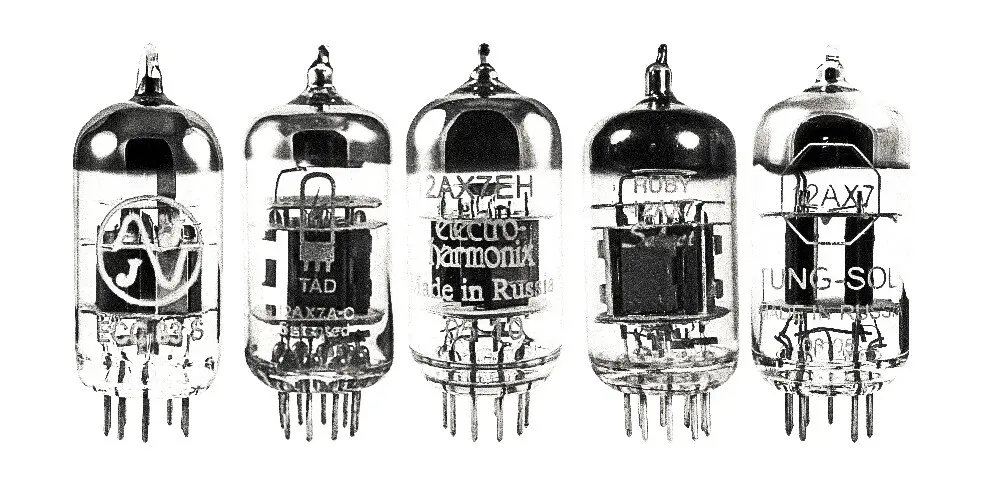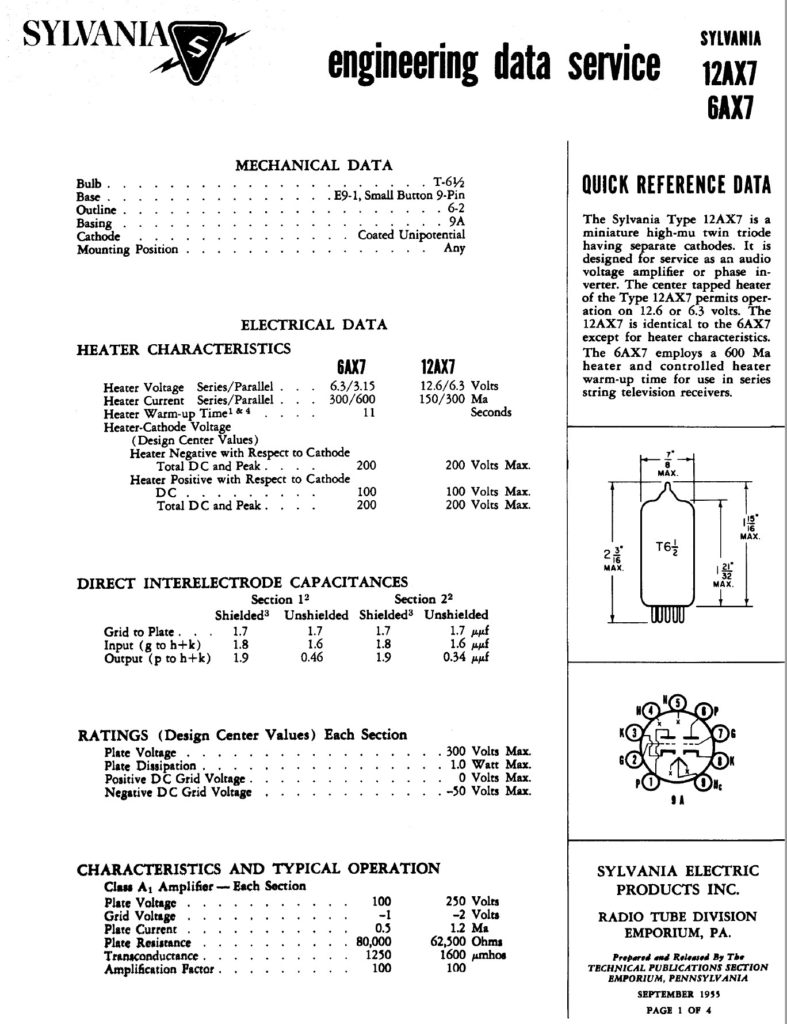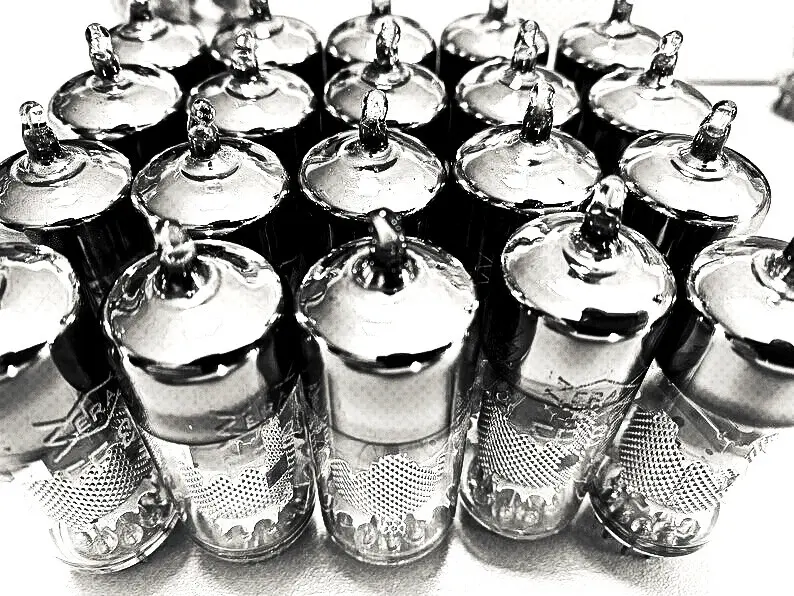12AX7 also known as ECC83, is a family of vacuum tubes. There are miniature low-frequency double triodes with a high voltage gain and low slope of the transfer characteristic.

In addition to the original 12AX7 and its improved European version ECC83, the family includes more than 200 options. The electrical characteristics of most of these vacuum tubes are identical. More than that, if we are speaking about 12AX7 vacuum tube it became synonymous with ECC83.
12AX7 and ECC83 combined, became the most used tube to amplify low-frequency voltage. They absolutely dominated the American and Western European household appliances of the 1950s and 1960s. By the end of the 1980s, the production of 12AX7 ceased, but in the 1990s it was resumed in China , Russia , Serbia and Slovakia. The main application of 12AX7 in the 21st century is tube guitar amplifiers .
What is 12AX7 Vacuum Tube: Table of Contents
12AX7 Vacuum Tube: A Little History
In March 1948, a new miniature vacuum tube appeared in the catalogs of the American companies RCA and Sylvania, a double triode for industrial automation devices which was named 12AX7. 12AX7 was developed by RCA, and was contracted at Sylvania factories. Companies did not have any particular hopes for the new tube. It wasn’t even worth a note in the corporate RCA magazine. The designers only combined two triodes in one cylinder, identical to the triode section of the previously released 6AV6 diode-triode vacuum tube .
12AX7 Vacuum Tube: Datasheet (Sylvania)

The combination of a high gain and low noise level embedded in the 6AV6 design turned out to be in high demand by the manufacturers of high-quality sound equipment and analog computers. So they have made the upgrade to 12AX7 Vacuum Tube . The main factor behind the unexpected success of 12AX7 was the release of long-playing recorders and players with low-sensitivity magnetic pickups into the US market. Mass equipment manufacturers urgently needed a low-cost, high-gain tube suitable for use in phono stage. Demand grew so rapidly that in 1952, five corporations were already releasing 12AX7: CBS , GE , National Union, Sylvania and Tung-Sol.

In the first years of production 12AX7 Vacuum Tube was clearly inferior in sound quality to its predecessor, 6SL7. Despite this, the 12AX7 replaced the “obsolete” 6SL7 and by 1956 it became the de facto industry standard for American market. The non-linearity of 12AX7 did not stop this. The designers of the 1950s were able to correct the flaws of the tubes with negative feedback . Therefore, 12AX7 found a place in the professional (tape recorders Ampex ) and in household equipment, and in guitar amplifiers, also.
Currently, 12AX7 and ECC83 are the most popular tubes used in the circuitry of guitar amplifiers. Manufacturers often choose these tubes due to their cost-effectiveness and the fact that they are readily available. Many modern amplifiers are designed based on proven schematics from the 1950s, as designers such as Leo Fender specifically chose the 12AX7 for its ideal characteristics in input overload mode and amplitude limits.
12Ax7 Vacuum Tube: The Decline of a Legend
In the 1960s, the vacuum tube industry began to decline, with American and European companies leaving the market or switching to reselling mediocre Japanese vacuum tubes. Only a few companies, such as Amperex and Mullard, maintained the quality of their ECC83 tubes until the 1980s. By the late 1980s, production of vacuum tubes had stopped at many companies, including GE, RCA, and Sylvania.
However, the demand for 12AX7 and ECC83 tubes was still present, particularly in the guitar amplifier market. In the 1990s, the market was flooded with low-quality tubes, many of which were falsely labeled as high-quality brands such as Amperex and Mullard. By 1995, there were only four remaining production facilities for 12AX7 and ECC83 tubes: EI Tubes in Serbia, Sino in China, Tesla in the Czech Republic, and the Russian Reflector plant.
These tubes were inferior to their West European counterparts, but by 2000 the Chinese facility had stopped production, and the Serbian facility had improved the quality of their tubes. In recent years, Russian-made tubes have been sold in the United States under the classic brands such as Genalex Gold Lion, Mullard, and Tung-Sol.
FAQs about 12AX7 Vacuum Tubes
The following section provides concise answers to frequently asked questions about 12AX7 vacuum tubes received through the search bar. The FAQs section about 12AX7 Vacuum Tube will be frequently updated with new inquiries.
When was the 12AX7 vacuum tube developed?
The 12AX7 vacuum tube, also known as ECC83 in Europe, was first introduced by the American electronics company RCA in 1947. The 12AX7 was designed for use as a voltage amplifier in vacuum tube audio amplifiers, guitar amplifiers, and other electronic equipment. It quickly became a popular choice among manufacturers and musicians alike due to its high gain, low noise, and versatility, and it continues to be widely used today in a variety of applications.
What was the purpose of developing 12AX7 vacuum tube?
The 12AX7 vacuum tube was developed to serve as a preamplifier in electronic circuits, particularly in audio applications such as guitar amplifiers, hi-fi systems, and other audio equipment. Its primary purpose is to amplify weak signals from instruments, microphones, or other audio sources and prepare them for further amplification or processing.
The 12AX7 tube’s high voltage gain and low noise characteristics made it a popular choice for guitar amplifier designers due to its ability to produce distortion and overdrive when pushed hard, which became a signature sound of rock music.
How is a 12AX7 triode typically configured?
A 12AX7 triode is typically configured as a preamplifier stage in electronic circuits. It is often used in audio amplifiers, guitar amplifiers, and other electronic devices that require signal amplification.
The triode has three pins: the cathode, the grid, and the anode. In a typical configuration, the cathode is grounded, the anode is connected to a high voltage supply, and the grid is connected to a low-level input signal source. The signal passing through the grid causes a small current to flow through the tube, which is amplified by the tube’s internal structure and then passed on to the output stage of the amplifier.
The 12AX7 is a dual triode, which means that it contains two separate triodes in a single vacuum tube. This makes it ideal for use in applications where two preamplifier stages are needed, such as in a stereo amplifier.
What is the amplification factor of a 12AX7 vacuum tube?
The typical amplification factor of the 12AX7 tube is 100.
What is the Miller capacitance of the 12AX7 tube?
The 12AX7 tube has a relatively high Miller capacitance, which makes it unsuitable for radio-frequency use.
What is the voltage gain formula for the 12AX7 tube?
The voltage gain (Av) of the 12AX7 tube can be calculated using the following formula: Av = μ × Rtot / (rP + Rtot + (RK × (μ + 1))), where μ is the amplification factor of the tube, rP is the internal plate resistance, RK is the cathode resistor, and Rtot is the parallel combination of the external plate resistor (RP) and the load resistor (Rload).
What is the meaning of the “12” in the designator for 12AX7 vacuum tube?
The initial “12” in the designator of the 12AX7 tube implies a 12-volt heater requirement. However, the tube has a center-tapped heater so it can be used in either 6.3-V or 12.6-V heater circuits.
What other vacuum tube designs are similar to 12AX7?
Some similar twin-triode designs to the 12AX7 tube include the 12AT7, 12AU7, 12AV7, 12AY7, and the low-voltage 12U7, plus many four-digit EIA series dual triodes. These tubes were designed for enhanced ruggedness, low microphonics, stability, and lifespan, and they span a wide range of voltage gain and transconductance.
Which vacuum tube is suitable for high-frequency applications?
Vacuum tubes that are suitable for high-frequency applications typically have a high cutoff frequency and low capacitance. One such tube is the 6DJ8, which is a twin triode tube designed for use in radio frequency and audio frequency circuits. Other vacuum tubes commonly used in high-frequency applications include the 6CW4, 6BK7, and the 6U8A. However, the specific tube chosen for a particular application depends on the requirements of that application, such as the desired frequency response, power handling capabilities, and voltage gain needed.

